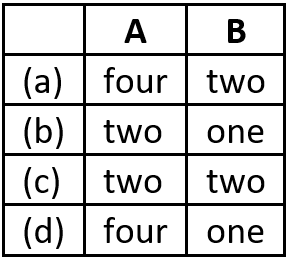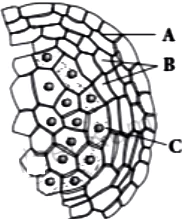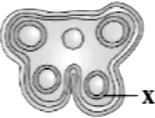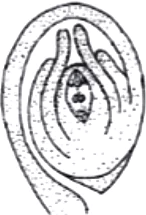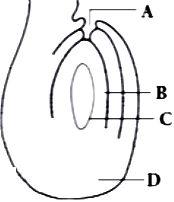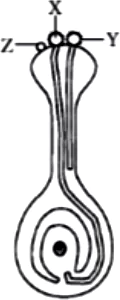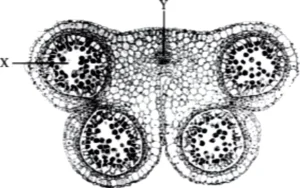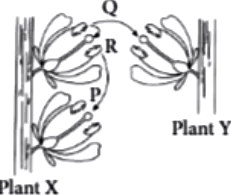Case Study Question 01
Read the following and answer any four questions from 1 to 5 given below:
Apomixis is a mode of reproduction which does not involve formation of zygote through gametic fusion. In plants, apomixis commonly mimics sexual reproduction but produces seeds without fertilisation. There are several methods of apomictic development in seeds. The two common ones are recurrent agamospermy and adventive embryony.
Question.1. Apomixis is a type of reproduction in plants in which
(a) fertilisation does not take place
(b) male nucleus takes part in fertilisation
(c) pollen fusion takes place
(d) generative nucleus takes part in fertilisation.
Question.2. Which of the following statements is incorrect regarding recurrent agamospermy?
(a) It is the formation of seed that has an embryo formed without meiosis and syngamy.
(b) All the cells of embryo sac are diploid.
(c) An embryo develops directly from a diploid cell other than egg like that of nucleus and integument.
(d) None of these
Question.3. Adventive embryony is found in
(a) Citrus
(b) Opuntia
(c) Apple
(d) Both (a) and (b)
Question.4. Formation of embryo directly from diploid egg without fertilisation is called
(a) apospory
(b) diplospory
(c) polyembryony
(d) diploid parthenogenesis.
Question.5. If any somatic cell of sporophyte produces gametophyte without reduction division, it is called
(a) parthenogenesis
(b) apogamy
(c) apospory
(d) amphimixis.
Ans.1. (a)
Ans.2. (c)
In recurrent agamospermy all the cells of embryo sac are diploid as it is formed directly either from a nuclear cell or diploid megaspore mother cell.
Ans.3. (d)
In adventive embryony, an embryo develops directly from a diploid cell other than egg like that of nucleus and integument, e.g., Citrus, Opuntia.
Ans.4. (d)
Formation of embryo directly from diploid egg It is found in Rubus, apple, Poa. without fertilisation is called diploid parthenogenesis.
Ans.5. (c)
Case Study Question 02
Read the following and answer any four questions from 1 to 5 given below:
The anther is a four-sided structure consisting of four microsporangia located at the corners two in each lobe. The microsporangia develop further and become pollen sacs. In a transverse section, a typical microsporangium appears near circular in outline. It is generally surrounded by four wall layers-the epidermis, endothecium, middle layers and the tapetum.
Question.1. A dithecous anther consists of \underline{A} microsporangia, \underline{B} in each lobe.
Select the option that correctly fills the blanks.
Question.2. The given diagram shows microsporangium of a mature anther. Identify A, B and C.
Question.3. The function of labelled part X is
(a) dehiscence
(b) mechanical
(c) nutrition
(d) protection
Question.4. Select the incorrect statement.
(a) Microsporangium is generally surrounded by four wall layers-epidermis, endothecium, middle layers and tapetum.
(b) Outer three layers perform functions of protection and dehiscence of anthers.
(c) Cells of tapetum possess dense cytoplasm and generally have more than one nucleus.
(d) Cells of tapetum undergo meiosis and produce microspore tetrads.
Question.5. Which function of tapetum is correct?
(a) Helps in pollen wall formation.
(b) Transportation of nutrients to inner side of anther.
(c) Synthesis of callase enzyme for separation of microspore tetrads.
(d) All of these
Ans.1. (a)
A typical angiosperm anther is bilobed with each lobe having two theca, i.e., dithecous and a dithecous anther is tetrasporangiate having four microsporangia, two in each lobe.
Ans.2. (c)
Ans.3. (c)
The tapetal layer is of great physiological significance as all the food material entering into the sporogenous tissue diffuses through this layer. Ultimately the cells of tapetal layer disorganise. Thus, tapetum makes a nutritive layer for the developing microspores or pollen grains.
Ans.4. (d)
Ans.5. (d)
Tapetum secretes Ubisch bodies which get covered with sporopollenin and so increase thickness of exine of pollen grain wall. Tapetum provides nourishment to developing microspores. It also secretes callase enzyme which dissolves callose substances by which four pollens of a pollen tetrad are united, hence separating microspores or pollens of a tetrad.
Case Study Question 03
Read the following and answer any four questions from 1 to 5 given below:
The endosperm makes the main source of food for the embryo. Generally the endosperm nucleus divides after the division of the oospore, but in several cases the endosperm is formed to a great extent even before the first division of the oospore. There are three general types of endosperm formation:
(a) nuclear type,
(b) cellular type and
(c) helobial type.
The endosperm is usually triploid but haploid endosperm is also found. Endosperm may either be completely consumed by the developing embryo before seed maturation or it may persist in the mature seed.
Question.1. Haploid endosperm is found in
(a) Pinus
(b) cauliflower
(c) sunflower
(d) pea
Question.2. Persistent endosperm is found in
P. Pea
Q. Castor
R. Bean
S. Coconut
T. Groundnut
(a) Q and S
(b) P and T
(c) R, S and T
(d) P, S and T.
Question.3. Milk of tender coconut represents \underline{A} and the surrounding white coconut meal represents \underline{B} .
Question.4. If an endosperm cell of a gymnosperm contains 12 chromosomes, the number of chromosomes in each cell of the root will be
(a) 4
(b) 24
(c) 16
(d) 6
Question.5. In angiosperms, normally after fertilisation
(a) the zygote divides earlier than the primary endosperm nucleus
(b) the primary endosperm nucleus divides earlier than the zygote
(c) both the zygote and primary endosperm nucleus divide simultaneously
(d) both the zygote and primary endosperm nucleus undergo a resting period.
Ans.1. (a)
In gymnosperms, the endosperm is haploid (n) and forms a continuation of the female gametophyte.
Ans.2. (a)
In some seeds, the endosperm persists in the seed as food storage tissue. Such seeds are called endospermic or albuminous, e.g., castor, maize, wheat, barley, rubber and coconut.
Ans.3. (b)
In coconut (Cocos nucifera), the surrounding white kernel called coconut meal is cellular endosperm and the coconut water (also called coconut milk) in the centre is free nuclear endosperm made up of thousands of nuclei.
Ans.4. (b)
The endosperm of a gymnosperm is haploid (n), while the cells of the root are diploid (2n). So, the number of chromosomes in the root will be 24.
Ans.5. (b)
Case Study Question 04
Read the following and answer any four questions from 1 to 5 given below:
Embryo develops at the micropylar end of the embryo sac where the zygote is situated. Most zygotes divided only after certain amount of endosperm is formed. The early stages of embryo development are similar in both monocotyledons and dicotyledons. The zygote gives rise to the proembryo and subsequently to the globular heart-shaped and mature embryo. A typical dicotyledonous embryo consists of an embryonal axis and two cotyledons. Embryo of monocotyledons possess only one cotyledon.
Question.1. True embryo develops as a result of fusion of
(a) two polar nuclei of embryo sac
(b) an egg cell and a male gamete
(c) synergid and male gamete
(d) a male gamete and antipodals.
Question.2. Refer to the given diagram of the embryo of an angiospermous plant with parts labelled P, Q and R. Select the correct statement(s) regarding this.
(i) Part ‘P’ supplies nutrition to the developing embryo.
(ii) Part ‘Q’ is the protective sheath of radicle and root cap.
(iii) Part ‘R’ is the protective sheath of shoot apex and leaf primordia.
(iv) The embryo shown in the diagram is present in members of Family Poaceae.
(a) (iv) only
(b) (ii) and (iii) only
(c) (i) and (iv) only
(d) (i), (ii), (iii) and (iv)
Question.3. Which of the given statements are true?
(i) During the development of a dicot embryo, heart-shaped embryo is followed by globular embryo.
(ii) The part of embryonal axis above the level of cotyledons is epicotyl, while the part below the level of cotyledons is hypocotyl.
(iii) Monocot seeds possess a single cotyledon represented by scutellum.
(a) (i) and (ii)
(c) (i) and (iii)
(b) (ii) and (iii)
(d) (i), (ii) and (iii)
Question.4. Consider the following parts of an embryonal axis of a dicot seed.
(i) Hypocotyl
(ii) Epicotyl
(iii) Radicle
(iv) Plumule
In which of the following the above parts are correctly arranged from top to base?
(a) (iii) → (i) → (ii) → (iv)
(b) (ii) → (i) → (iii) → (iv)
(c) (iv) → (ii) → (i) → (iii)
(d) (iii) → (iv) → (ii) → (i)
Question.5. In grass family, the cotyledon is called
(a) epiblast
(b) plumule
(c) scutellum
(d) perisperm
Ans.1. (b)
In double fertilisation, out of the two male gametes one fuses with egg or oosphere to perform generative fertilisation. Generative fertilisation is also called syngamy or true fertilisation. It gives rise to a diploid zygote or oospore.
Ans.2. (c)
Ans.3. (b)
During the development of dicot embryo, initially the dicot embryo is globular and undifferentiated. Early embryo with radial symmetry is called proembryo. It is transformed into embryo with the development of radicle, plumule and cotyledons. Two cotyledons differentiate from the sides with a faint plumule in the centre. At this time the embryo becomes heart-shaped.
Ans.4. (c)
Ans.5. (c)
In the grass family, the cotyledon is called scutellum that is situated towards one side (lateral) of the embryonal axis.
Case Study Question 05
Read the following and answer any four questions from 1 to 5 given below:
A typical angiospermic ovule is a small structure attached to the placenta by means of a stalk called funicle. The body of the ovule fuses with funicle in the region called hilum. Each ovule has one or two protective envelopes called integuments. Integuments encircle the nucellus except at the tip where a small opening called the micropyle is formed. Mature ovules are classified on the basis of funiculus. It can be orthotropous, anatropous, hemitropous, campylotropous, etc.
Question.1. The body of the ovule consists of a mass of parenchymatous cells called
(a) integuments
(b) nucellus
(c) hilum
(d) funiculus
Question.2. Refer to the given figure and select the correct statement regarding it.
(a) This type of ovule is found in cactus.
(b) The micropyle comes to lie close to the funiculus due to unilateral growth of ovule.
(c) It is most common type of ovule found in the members of Chenopodiaceae.
(d) It is half inverted ovule.
Question.3. Identify the parts labelled as A, B, C and D in the given figure and select the correct option.
Question.4. Mature ovules are classified on the basis of funiculus. If micropyle lie close to the funiculus, the ovule is termed as
(a) orthotropous
(b) anatropous
(c) hemitropous
(d) campylotropous
Question.5. In Asphodelus, ovule is
(a) unitegmic
(b) tritegmic
(c) bitegmic
(d) ategmic.
Ans.1. (b)
Ans.2. (a)
The given figure is of circinotropous ovule where funiculus coiled around the ovule. It is found in the Family Cactaceae.
Ans.3. (d)
Given figure represents an anatropous ovule where A, B, C and D represent micropyle, nucellus, embryo sac and chalaza respectively.
Ans.4. (b)
Depending upon the configuration and orientation of the body of ovule in relation to funiculus, there are six types of ovule – orthotropous (atropous, erect), anatropous (inverted), hemitropous (half inverted), campylotropous (body curved), amphitropous (both body and embryo sac curved) and circinotropous (funiculus coiled around the ovule).
Anatropous or inverted ovule is the most common type of ovule found in angiosperms (in 80% of angiosperm families). Here, body of the ovule gets inverted and micropyle is on lower side. Further micropyle and funiculus lie side by side and micropyle is close to hilum.
Ans.5. (b)
Case Study Question 06
Read the following and answer any four questions from 1 to 5 given below:
The pollen grains or microspores are the male reproductive bodies of a flower and are contained in the pollen sac or microsporangia. Each pollen grain consists of a single microscopic cell, possessing two coats: the exine and the intine. The exine of a pollen grain is made of chemically stable material. Because of this, pollen grains are often very well preserved for thousands of years in soil and sediments.
Question.1. One of the most resistant biological material present in the exine of pollen grain is
(a) pectocellulose
(b) sporopollenin
(c) suberin
(d) cellulose.
Question.2. The exine possesses one or more thin places known as
(a) raphe
(b) germ pores
(c) hilum
(d) endothecium
Question.3. What is the function of germ pore?
(a) Emergence of radicle
(b) Absorption of water for seed germination
(c) Initiation of pollen tube
(d) All of these
Question.4. What is the key advantage to the plant for having such strong pollen grain walls?
(a) It protects the vital genetic material in the pollen grain.
(b) It allows pollen to serve as a valuable fossil record for the study of ancient plants.
(c) It prevents the pollen tube from growing out before the pollen grain reaches the stigma of a compatible species.
(d) It gives weight to the pollen grain, allowing it to cling better to the body surfaces of insect pollinators.
Question.5. The number of germ pores in dicots and monocots respectively are
(a) one and three
(b) three and two
(c) two and three
(d) three and one.
Ans.1. (b)
Outer layer (exine) of pollen grain is made of a highly resistant substance called sporopollenin. It is not degraded by any enzyme and not affected by high temperature, strong acid or strong alkali.
Ans.2. (b)
Ans.3. (c)
One or more thin areas present in the exine of pollen grains are known as germ pores. The germ pores are apertures in the exine layer of the pollen grain where the sporopollenin is absent. The germ pore helps in the formation of the pollen tube and the release of the male gametes during fertilisation. There are usually three germ pores in dicots (tricolpate) and one in monocots (monocolpate).
Ans.4. (a)
The pollen grain wall helps to protect the male gametes from drying up or chemical attack, thus protecting the DNA in the male gametes. This helps to maintain the integrity of genetic material that would be inherited by subsequent generations.
Ans.5. (d)
Case Study Question 07
Read the following and answer any four questions from 1 to 5 given below:
Cross pollination is the transfer of pollen grains from the anther of a one flower to the stigma of a genetically different flower. It is performed with the help of an external agency which may be abiotic (e.g., wind, water) or biotic (e.g., insects, birds, bats, snails). The diagram shows the carpel of an insect pollinated flower.
Question.1. What is the most likely reason for non germination of pollen grain Z?
(a) Pollen grains X and Y were brought to the stigma earlier, therefore, their germination inhibited the germination of pollen grain Z..
(b) Pollen grain Z was brought to the flower by wind, while pollen grains X and Y were brought to the flower by insect.
(c) Pollen grain Z lacks protrusions that allow it to adhere properly onto the stigma surface.
(d) Pollen grain Z comes from a flower of an incompatible species.
Question.2. Which of the following best describes the function of the pollen tube?
(a) It acts as a conduit to transport male gametes from the anther to the ovule.
(b) It acts as a conduit to transport male gametes from the stigma to the ovule.
(c) It contains key nutrients that serve to nourish the newly-formed zygote.
(d) It digests the tissues of the stigma, style and ovary.
Question.3. Pollination of a flower in which the pollen is carried by an insect is called
(a) anemophily
(b) ornithophily
(c) entomophily
(d) malacophily
Question.4. Refer to the given characteristics of some flowers.
A. The stamens hang out of the flower, exposing the anthers to the wind.
B. The pollen grains are tiny and light.
C. The flower has a sweet scent.
D. The flower petals are brightly coloured.
How many of the above characteristics are of insect-pollinated flower?
(a) One
(b) Two
(c) Three
(d) Four
Question.5. Pollenkitt is generally found in
(a) anemophilous flowers
(b) entomophilous flowers
(c) ornithophilous flowers
(d) malacophilous flowers.
Ans.1. (d)
Pollen grains can only germinate if the pollen grain and style tissues are compatible, i.e., of the same or closely related species. Pollen grains X and Y must have come from a compatible species.
Ans.2. (b)
Ans.3. (c)
Entomophily is the type of pollination that takes place through the agency of insects. The insect- loving flower possesses various adaptations by which they attract insects and use them as carrier of pollen grains for the purpose of cross pollination.
Ans.4. (b)
Insect-pollinated flowers produce nectar, which attract the pollinators for feeding. Some flowers produce edible pollen grains. Flowers are fragrant and emit scent and odour. These are brightly coloured. The pollen grains are spiny, heavy and surrounded by a yellow sticky substance called pollenkitt.
Ans.5. (b)
Case Study Question 08
Read the following and answer any four questions from 1 to 4 given below:
Many adaptations are found in flowers to achieve certain kind of pollination. The pollination achieved by insects is known as entomophily. The given diagram shows the cross-section of an anther of an insect pollinated flower.
Question.1. Which of the following is/are the function(s) of structure Y?
A. To carry waste products away from the anther.
B. To supply oxygen to the cells of the anther.
C. To transport food and mineral salts to the anther.
D. To supply water to the anther.
(a) C only
(b) C and D only
(c) A, B and D only
(d) A, B, C and D
Question.2. Which of the following most accurately describes the structures found in compartment X?
(a) They contain two haploid nuclei resulting from meiosis.
(b) They contain two haploid nuclei resulting from mitosis.
(c) They contain two haploid male gametes resulting from mitosis.
(d) They produce abundant quantities of pollen to make up for pollen grains that might be removed by the wind.
Question.3. Which of the following are likely characteristics of the structures found in X and stamens of this plant?
Question.4. Spiny or sticky pollen grains and large, attractively coloured flowers are associated with
(a) hydrophily
(b) entomophily
(c) ornithophily
(d) anemophily.
Ans.1. (b)
Y is a vascular bundle comprising xylem that transports water and mineral salts to the anther, and phloem that transports sugars to the anther.
Ans.2. (b)
X contains pollen grains. Pollen grain contains two haploid nuclei resulting from mitosis, a generative nucleus and pollen tube/vegetative nucleus.
Ans.3. (b)
Insect-pollinated plants tend to have pollen with rough surfaces to allow them to cling more readily onto the body of insect pollinators. Their stamens are unlikely to be pendulous nor protrude outside the flower, since the pollen is not intended to be released into the air and carried away by the wind.
Ans.4. (b)
Entomophily type of pollination takes place through the agency of insects. The entomophilous flowers are brightly coloured and fragmented to attract the insects. Their pollen grains are sticky or spiny to easily get attached with the body of pollinators. When the insects visit the flowers, their body gets dusted with pollen grains, and when they fly and visit other flowers, they brush against the stigma which being sticky, at once receives the pollen grains from their body. Thus, cross-pollination is achieved.
Case Study Question 09
Read the following and answer any four questions from 1 to 5 given below:
In angiosperms, the pollen grains are being transferred from the anther to the stigma and is termed pollination. This phenomenon was first discovered by Camerarius (1694) in the end of seventeenth century. Pollen grains are immobile. They cannot reach the stigma by themselves. An external agent is required for this. The pollination is mainly of two types-self pollination and cross pollination.
The diagram given below shows two plants of the same species showing different types of pollination.
Question.1. What is transferred between the plants in the process indicated by arrow P?
(a) Ova
(b) Pollen
(c) Nutrients
(d) Seeds
Question.2. Which of the following statements is correct regarding processes P, Q and R?
(a) Processes P, Q and R introduce genetic variability in the offspring of sexually reproducing plants X and Y.
(b) Wind serves as agent for process Q if plants X and Y belong to Genus Salvia.
(c) Flowers of plants X and Y need to produce odour and nectar for completion of processes P and Q if they are entomophilous.
(d) If plants X and Y belong to Genus Cannabis, then their flowers need to produce sticky and heavy pollens in very small amount for accomplishment of process Q.
Question.3. Identify the processes P, Q and R.
Question.4. In Catharanthus, the growth of style brings the stigma in contact of ripe anthers present on the mouth of corolla tube. This is an example of
(a) homogamy
(b) cleistogamy
(c) geitonogamy
(d) xenogamy.
Question.5. Which of the given processes represents a type of pollination that would result in greater adaptability of the particular species to potential environmental changes?
(a) P
(b) Q
(c) R
(d) All of these
Ans.1. (b)
Ans.2. (c)
In the given figure, processes P, Q and R represent geitonogamy (self pollination), xenogamy (cross pollination) and autogamy (self pollination), respectively. Pollinating agents are required for accomplishment of processes P and Q but no agent is required for process R. Out of P, Q and R, only Q is responsible for introducing genetic variability as it is cross pollination between different plants of same species. Salvia is insect pollinated whereas Cannabis is wind pollinated plant.
Ans.3. (a)
Ans.4. (a) Homogamy occur in chasmogamous or open flowers where anthers and stigmas are brought together by growth, bending or folding.
Ans.5. (b)
Case Study Question 10
Read the following and answer any four questions from 1 to 5 given below:
Pollen-pistil interaction is the group of events that occur from the time of pollen deposition over the stigma to the time of pollen tube entry into ovule. It is a dynamic process which has checks at several places for promotion or inhibition of pollen growth. Pollen-pistil interaction is a safety measure to ensure that illegitimate crossings do not occur. Compatibility and incompatibility of the pollen-pistil is determined by special proteins. The compatible pollens are able to absorb water and nutrients from the surface of the stigma. They germinate and produce pollen tubes. Pollen tubes grow into the style. Their growth and path through the style are also determined by specific chemicals.
Question.1. Which of the following parts of gynoecium determines the compatible nature of pollen?
(a) Stigma
(b) Style
(c) Ovary
(d) Thalamus
Question.2. In Trifolium, which type of self-incompatibility is found?
(a) Gametophytic self-incompatibility (GSI)
(b) Sporophytic self-incompatibility (SSI)
(c) Both GSI and SSI
(d) None of these
Question.3. Select the incorrect statement.
(a) In Asteraceae, incompatibility is due to the genotype of the sporophytic stigmatic tissues.
(b) In members of Brassicaceae, incompatibility is due to the genotype of the pollen.
(c) Nature has imposed self-incompatibility to avoid highly homozygous individuals which have a very low survival value.
(d) None of these
Question.4. Which of the following are examples of self incompatibility?
(a) Tobacco
(b) Potato
(c) Crucifers
(d) All of these
Question.5. Given figures show the pollen-stigma interaction, where pollen wall proteins are released onto the pellicle of stigmatic papillae, where recognition reaction occurs.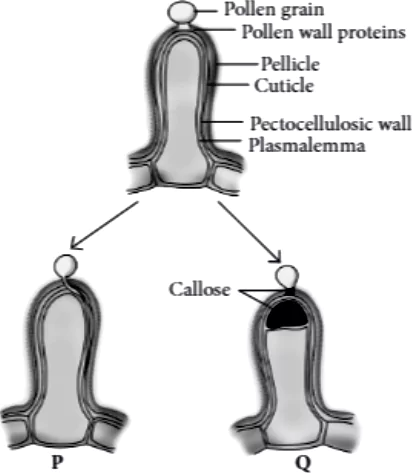
(a) P indicates compatible reaction in which the pollen tube penetrates the cuticle and grows down the papilla.
(b) Development of callose plug between the plasma membrane and pectocellulosic layer of stigmatic papillae results in the incompatibility reaction in Q.
(c) A callose plug which appears at the tip of pollen in Q, is dissolved by callase enzyme secreted by stigma resulting in compatibility reaction.
(d) Deposition of callose can be employed as a reliable bioassay to detect compatibility or incompatibility reactions of pollen and stigma.
Ans.1. (a)
Stigma is the terminal receptive part of the pistil which functions as landing platform for the pollen grains. It also determines the compatibility of the pollen grains.
Ans.2. (a)
Ans.3. (b)
In members of Brassicaceae, incompatibility is due to the genotype of the sporophytic stigmatic tissues.
Ans.4. (d)
Ans.5. (c)
The most distinct response of the stigma to an incompatible pollen is the development of callose plug between the plasma membrane and pectocellulosic layer of the stigmatic papillae, just below the point of contact with the pollen; a callose plug also appears at the tip of the pollen tube. With the appearance of the callose-plug, the growth of the pollen tube ceases. The deposition of callose in the stigmatic cells can be employed as a reliable bioassay to detect incompatible pollen particularly where the rejection occurs on the stigma. This bioassay has served as a useful aid in providing direct evidence for the involvement of exine-borne proteins in incompatibility reaction.


